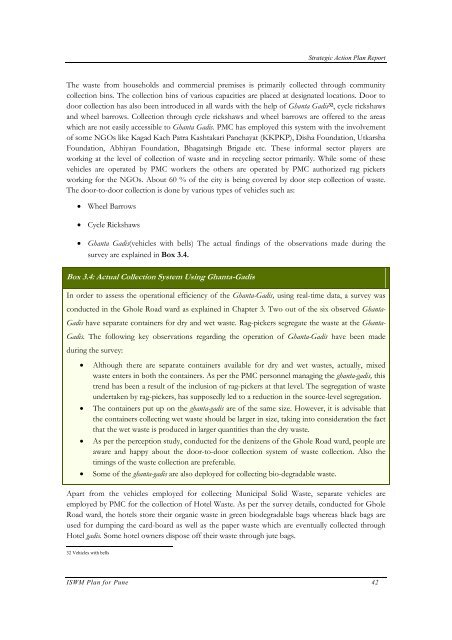Strategic Action Plan - International Environmental Technology Centre
Strategic Action Plan - International Environmental Technology Centre
Strategic Action Plan - International Environmental Technology Centre
Create successful ePaper yourself
Turn your PDF publications into a flip-book with our unique Google optimized e-Paper software.
<strong>Strategic</strong> <strong>Action</strong> <strong>Plan</strong> Report<br />
The waste from households and commercial premises is primarily collected through community<br />
collection bins. The collection bins of various capacities are placed at designated locations. Door to<br />
door collection has also been introduced in all wards with the help of Ghanta Gadis 32 , cycle rickshaws<br />
and wheel barrows. Collection through cycle rickshaws and wheel barrows are offered to the areas<br />
which are not easily accessible to Ghanta Gadis. PMC has employed this system with the involvement<br />
of some NGOs like Kagad Kach Patra Kashtakari Panchayat (KKPKP), Disha Foundation, Utkarsha<br />
Foundation, Abhiyan Foundation, Bhagatsingh Brigade etc. These informal sector players are<br />
working at the level of collection of waste and in recycling sector primarily. While some of these<br />
vehicles are operated by PMC workers the others are operated by PMC authorized rag pickers<br />
working for the NGOs. About 60 % of the city is being covered by door step collection of waste.<br />
The door-to-door collection is done by various types of vehicles such as:<br />
• Wheel Barrows<br />
• Cycle Rickshaws<br />
• Ghanta Gadis(vehicles with bells) The actual findings of the observations made during the<br />
survey are explained in Box 3.4.<br />
Box 3.4: Actual Collection System Using Ghanta-Gadis<br />
In order to assess the operational efficiency of the Ghanta-Gadis, using real-time data, a survey was<br />
conducted in the Ghole Road ward as explained in Chapter 3. Two out of the six observed Ghanta-<br />
Gadis have separate containers for dry and wet waste. Rag-pickers segregate the waste at the Ghanta-<br />
Gadis. The following key observations regarding the operation of Ghanta-Gadis have been made<br />
during the survey:<br />
• Although there are separate containers available for dry and wet wastes, actually, mixed<br />
waste enters in both the containers. As per the PMC personnel managing the ghanta-gadis, this<br />
trend has been a result of the inclusion of rag-pickers at that level. The segregation of waste<br />
undertaken by rag-pickers, has supposedly led to a reduction in the source-level segregation.<br />
• The containers put up on the ghanta-gadis are of the same size. However, it is advisable that<br />
the containers collecting wet waste should be larger in size, taking into consideration the fact<br />
that the wet waste is produced in larger quantities than the dry waste.<br />
• As per the perception study, conducted for the denizens of the Ghole Road ward, people are<br />
aware and happy about the door-to-door collection system of waste collection. Also the<br />
timings of the waste collection are preferable.<br />
• Some of the ghanta-gadis are also deployed for collecting bio-degradable waste.<br />
Apart from the vehicles employed for collecting Municipal Solid Waste, separate vehicles are<br />
employed by PMC for the collection of Hotel Waste. As per the survey details, conducted for Ghole<br />
Road ward, the hotels store their organic waste in green biodegradable bags whereas black bags are<br />
used for dumping the card-board as well as the paper waste which are eventually collected through<br />
Hotel gadis. Some hotel owners dispose off their waste through jute bags.<br />
32 Vehicles with bells<br />
ISWM <strong>Plan</strong> for Pune 42
















